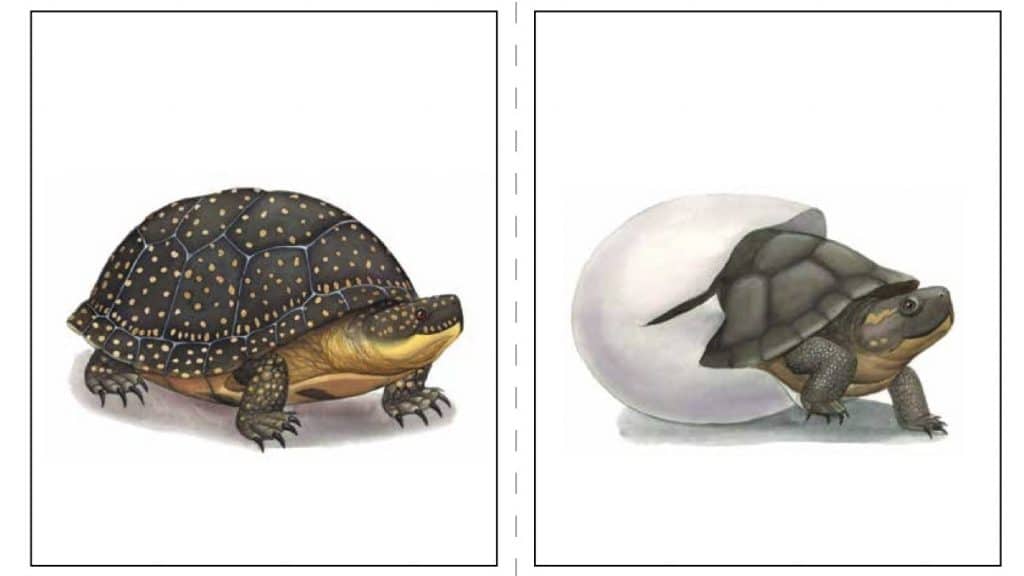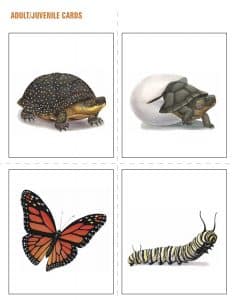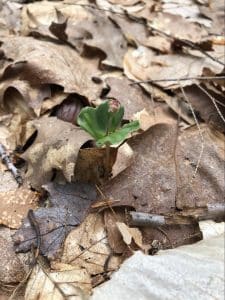
How do different plants or animals grow and develop? What stages of life can you see around you? Do young plants and animals always look exactly like their parents?
Step outside or peek out your window and you’re bound to see new life this time of year. Birds are laying eggs or caring for their nestlings, new leaves are emerging all around us, tadpoles may be hatching soon from their jelly-like eggs, and even baby woodchucks should be out snacking on fresh plants. Spring is when many life cycles in nature start over. We know that animals and plants reproduce in many different ways, and it’s also true that there are many different ways to grow up!
To start our study of life cycles, choose one Maine species and do a little research.
You might already know the basic stages of life for your species, but if not, you can use field guides or digital resources such as Cornell Lab of Ornithology’s All About Birds or the Maine Dept. of IF&W’s Species Information page.
Consider these questions as you learn or remember the way your species grows up:
How does this plant’s or animal’s life begin?
- As an egg in a nest, kept warm and cared for
- As a seed or acorn in soil
- Born live and fed by parents in a den
- Hatched on its own from a mass of eggs
- Some other way
2) How does this plant or animal grow and develop?
- By just growing larger over time, becoming more similar to the adult
- By greatly changing its features or adaptations as it develops (called complete metamorphosis, a process of development done by many insects and amphibians)
3) What are the different stages of life this species goes through?
- Egg, juvenile/immature, adult
- Egg, nestling, 1st-year, adult
- Pup/kit/cub, adult
- Seed, sprout, seedling, tree
 These Adult/Juvenile Cards from our Wildlife on the Move Monarch Butterfly Teaching Guide offer a few wildlife examples you could choose to study:
These Adult/Juvenile Cards from our Wildlife on the Move Monarch Butterfly Teaching Guide offer a few wildlife examples you could choose to study:
Birds and their chicks/eggs
Bats and their babies
Turtles and their hatchlings
Butterflies and caterpillars
There are also examples we’ve already explored here through Elementary Connections, such as the frog development we began observing together a few weeks ago.
What changes as this species grows? What stays the same?
With pictures and/or information about the life cycle of your species, get ready to compare and contrast. What is different between the young and the adult? What stays the same throughout the life cycle?
Consider using a Venn Diagram to record this in your nature journal (two large overlapping circles): use the left circle to describe the young or juvenile, the right circle to describe the adult, and the overlapping space between for traits that stay the same.
What does your species have in common between the adults and young? What are the biggest differences you notice?
 If the species you chose to investigate is an animal, think about how you could track these life stages in a plant near where you live. A garden with seeds or seedlings will give you a great glimpse of this step-by-step development but so will looking closely beneath an oak tree for any of its acorns (seeds) beginning to sprout!
If the species you chose to investigate is an animal, think about how you could track these life stages in a plant near where you live. A garden with seeds or seedlings will give you a great glimpse of this step-by-step development but so will looking closely beneath an oak tree for any of its acorns (seeds) beginning to sprout!
I was recently trying to identify this small sprig of green growth I found sprouting in a forest of oak and beech tree. There were many around just like it. After a little Internet research, it turned out to be a baby (seedling) American Beech tree!
What new growth can you find near you? Is it the same or different from the adult plant it came from?
Our educators, scientists, advocates, and naturalists are committed to keeping you connected to the natural world as we deal with the coronavirus situation together. Check in every weekday on our Connections page for family activities, parent/teacher tips, backyard birding, nature exploration at our sanctuaries, and more.
Next Generation Science Standards: “Crosscutting Concepts” for all Elementary Grades in this module:
- Patterns
- Structure and Function
- Stability and Change
K Performance Expectations:
- Use observations to describe patterns of what plants and animals (including humans) need to survive. K-LS1-1
1st Grade Performance Expectations:
- Make observations to construct an evidence-based account that young plants and animals are like, but not exactly like, their parents. 1-LS3-1
2nd Grade Performance Expectations:
- Make observations of plants and animals to compare the diversity of life in different habitats. 2-LS4-1
3rd Grade Performance Expectations:
- Develop models to describe that organisms have unique and diverse life cycles but all have in common birth, growth, reproduction, and death. 3-LS1-1
- Analyze and interpret data to provide evidence that plants and animals have traits inherited from parents and that variation of these traits exists in a group of similar organisms. 3-LS3-1
4th Grade Performance Expectations:
- Construct an argument that plants and animals have internal and external structures that function to support survival, growth, behavior, and reproduction. 4-LS1-1
NGSS Lead States. (2013). Next Generation Science Standards: For States, By States. Retrieved from http://www.nextgenscience.org/
